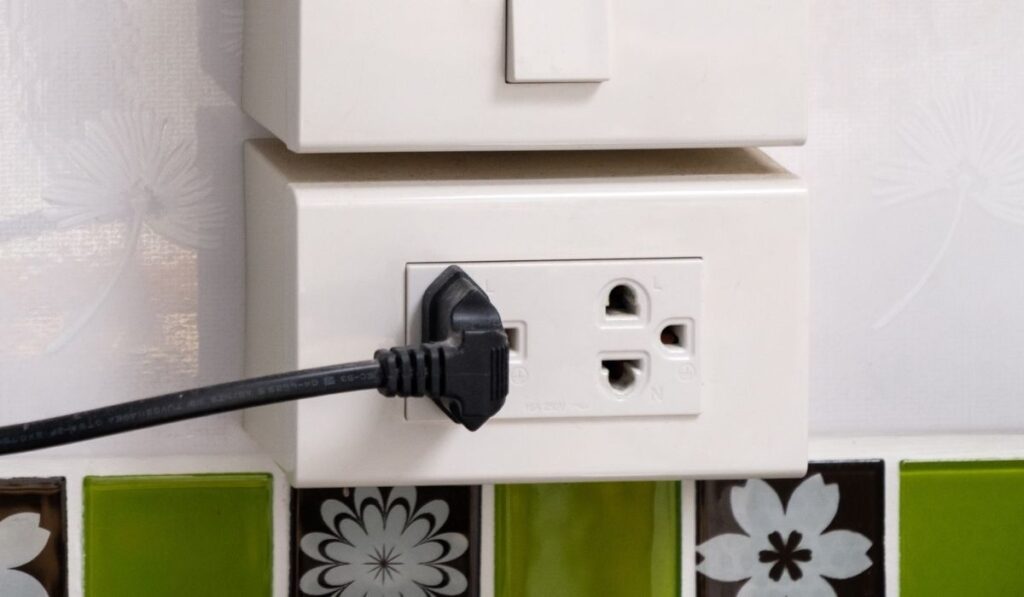GFCI tripping is one of those household problems that seems to sneak up on you when you least expect it and then causes immense frustration. Some basic knowledge can help you be prepared to deal with this issue should it happen to you.
Your fridge might be tripping the GFCI due to a faulty connection system, a short circuit, the presence of water or exposed wires, or simply a false alarm. Try to diagnose the specific problem and then replace any damaged or dysfunctional parts as needed.
In this guide, we’ll give you a rundown of the factors that cause your fridge to trip a GFCI and all the possible remedies. And if you are the call-a-technician kind of person, this post will equip you with basic knowledge to help you understand what a GFCI is, how it operates, and when to call for help.
What Is a GFCI Outlet?

GFCI is an abbreviation for Ground Fault Circuit Interrupter. This is a specialized electrical outlet designed to prevent people from being electrocuted. It does this by detecting when the current flow in the circuit deviates from what it should be — and then cutting the power before anyone gets hurt.
This type of outlet is also sometimes referred to as a Ground Fault Interrupter (GFI), although there is a slight difference between the two. GFI protects an individual outlet, while GFCI protects an entire circuit that serves several outlets.
How Does a GFCI Work?
Normally, electricity flows to your fridge through the wires. But if there is any fault, electricity stops flowing and surges up in the cables.
If such a surge is not addressed, it becomes a hazard and will quickly find an ‘exit route’ to the ground through any conductor that it comes into contact with. If it comes into contact with a human, it could cause electrocution, which may lead to harm or even death. This is where a GFCI comes into play.
It determines whether electricity is flowing as expected, and if there is a surge, it detects it and quickly shuts off power before the situation takes a turn for the worse.
The GFCI outlet has two buttons on its face — one labeled “test” (typically red) and another labeled “reset” (usually black). The test button runs a quick check to make sure everything is working properly, while the reset button restores regular operation once you’ve fixed whatever caused it to trip in the first place.
Uses and Types and GFCIs
GFCIs are mainly used on construction sites. However, you will also find them in individual homes and residential buildings. These devices are also used in bathrooms and kitchens (or other wet areas) to protect against electric shock if something falls into the water and creates an electrical ground fault.
There are many variations of GFCI units in the market, the major ones are:
- Cord-connected: This is an attachment type that comes with the GFCI.
- Portable: This type is easy to transport and easily plugs into non-GFCI outlets.
- Receptacle: These are low-cost and incorporate themselves into one or many receptacle outlets.
Should You Plug a Refrigerator Into a GFCI Outlet?
Your refrigerator may or may not need to be plugged into a GFCI outlet. It depends on several factors, including the following:
- Condition of Your Home
In most cases, it’s not a requirement to connect your fridge to a GFCI system, although a moist ground may necessitate a connection.
This is because the dampness creates a higher chance of electric shock if a GFCI device is not used.
- NEC Law
The law isn’t always specific about connecting fridges to GFCI outlets. However, you should keep yourself informed of any changes because non-compliance may lead to hefty fines.
The law is mainly concerned with water outlet locations that pose a danger, such as kitchens and bathrooms.
- Your Preferences
Fridges commonly trip GFCI outlets, and this may frustrate you and prompt you to unplug your device. Despite there being no imminent danger, it’s crucial to seek an expert’s opinion to avoid unforeseen risks.
- Expert Opinion
If you’re not certain whether you should use a GFCI outlet, consult an expert. They’ll be able to give you the best advice on how to proceed safely.
Why Does Your Refrigerator Keep Tripping the GFCI?

As briefly mentioned above, the reasons may be due to the electrical connection within the fridge, GFCI, or the entire connection. It may also be due to other factors such as:
- Water
- Exposed wires
- The fridge defrosting
- Short circuit
- False Alarms
To determine the actual cause, you should test each option to decide whether it’s the cause before moving to the next element. Let’s dive deeper into the possible causes:
- Water
GFCI systems are designed to protect users in the case that water gets near or in the outlet. Therefore, if the device detects moist surroundings, it will trip.
- Exposed and Damaged Wires
One of the primary functions of a GFCI is to help detect any power surge. Exposed wires have the overall effect of ‘leaking’ power, which is dangerous to the users and the fridge.
The wires may be from the power cord, power plugs, fridge, and outlet.
When a GFCI detects them, it will trip. The main challenge with this factor is that it may take you more time before you realize the actual cause of the tripping.
- Defrosting Fridge
Some fridges, especially older models, do not have a self-defrosting system. And since defrosting is an essential function, your GFCI may trip when the fridge performs this function.
The tripping arises due to a change in power flow, causing the GFCI outlet to react. It’s also due to the high energy levels required for the defrosting process.
- Short Circuit
Just like exposed wires, a short circuit can cause a fridge to trip a GFCI outlet. When there is no smooth power flow, the device will detect this and trip, to protect you just as it’s designed to do.
- False Alarms
Fridges are high-power consumers, especially when the cooling cycle begins. A GFCI outlet may pick this up as a faulty connection and trip. This is also known as ‘nuisance tripping’ and is the leading cause of GFCI trips.
It is also why many technicians don’t recommend connecting a fridge to a GFCI, although there is a simple way to rectify the problem.
How to Stop Your Refrigerator From Tripping the GFCI
Regardless of the cause of the GFCI trip, it’s clear that the trips are frustrating. And let’s face it, it’s more hectic if you don’t know how the system works or if you don’t know a reliable technician to help you out.
If you choose to plug your fridge into the GFCI, you can take several measures to prevent frequent and annoying trips.
1. Check, Reset, and Replace the GFCI
Nuisance tripping is one of the leading types of GFCI tripping. This happens because the GFCI is highly sensitive and may trip unnecessarily during the fridge’s cooling cycles. However, you can avoid this by checking and resetting the device.
Additionally, the system can develop mechanical issues. And even if you’ve replaced your fridge recently, it might also be time to replace the GFCI. This is recommended if the new refrigerator is not compatible with the interrupter.
2. Check and Replace the Power Cord
If the problem persists after checking the GFCI, you need to check the power cord next. Any damage, such as exposure or being loose, may cause a short circuit triggering the interrupter to trip.
To address this problem, inspect the cord and replace it if any damage is visible.
3. Check and Replace the Refrigerator Wiring
You should also check your refrigerator’s wiring to rule out any damage, loose connection, or other faults. This can easily be achieved by unplugging the fridge from the power source and checking every wire for faults.
Pro tip: Wire checking and replacement are not necessarily challenging tasks. However, they should be carried out by a qualified technician for safety concerns.
If you decide to do it yourself, make sure you get the right tools. You should also follow these steps:
- First, determine the actual cause of the tripping.
- You should then remove the wires from the outlet, replacing them with new ones.
- Loosen terminal screws and remove the wire. Disconnect the damaged wire from both screws by loosening their respective terminals with a screwdriver.
- Strip insulation off the new wire. Strip off about 2 inches of plastic coating on each end of your replacement wire.
- Connect the new wire. Tightly wrap the copper wire around each terminal screw and re-tighten the screw with your screwdriver so that enough copper is visible beyond each side of the screw head.
- Secure terminal screws and test. Replace the outlet cover plate, plug in an appliance or appliance power strip, and reset your GFCI outlet by pushing its “Test” button once again until it clicks off.
Be sure to hold down its “Reset” button if necessary to keep it from tripping again immediately after you push “Test.”
If everything works correctly now, you’re good to go. If not, double-check that you’ve correctly secured all wires and their connections between their respective terminals and try testing again or hire an electrician if problems persist.
4. Check and Replace the Power Plugs
The power plugs may also be the cause of a GFCI tripping. If they are loose, rusty, broken, or damaged, you need to replace them or the entire cord.
5. Reduce Connection to the Circuit the Fridge Is Connected to
If many appliances are connected to the same circuit, that system may be overloaded, causing the GFCI to trip. The remedy is to have a circuit sorely dedicated to your fridge.
6. Use Adapters on Your Fridge
Sometimes a GFCI trips from the normal functioning of the refrigerator. The defrost cycle needs more power and may create a power surge that the GFCI interprets as a faulty connection, causing it to trip.
If this happens every few hours, there is no need to worry, but you can install adapters to prevent the trips.
7. Check the Power Outlet
A burnt or loose connection may also contribute to a GFCI tripping. However, you can address this problem by checking the power outlet and replacing it when necessary.
8. Test the Defrost Heater and Replace It if Necessary
Despite the defrosting cycle being a ‘normal’ cause for GFCI tripping, the heater may be faulty and cause the same problem.
To differentiate between the two, test the heater by resetting the time for the cycle to begin. If there’s a trip, there’s a problem, and the heater may need replacement.
9. Check and Replace the Compressor or Overhaul the Fridge
If you’ve done all of the above and the tripping persists, the likely cause is a faulty compressor. A defective compressor causes the fridge to work more, which triggers the GFCI to read this as a power surge.
You should note, however, that replacing the compressor is expensive, and many technicians recommend purchasing a new unit.
10. Unplug the Fridge
Another final option to escape the tripping menace would be to unplug the refrigerator altogether. Refrigerators don’t necessarily need to be plugged into a GFCI because it consumes more power during defrosting, and it can self-regulate.
Rather than keep checking why the interrupter keeps on tripping, it would be better to unplug your fridge.
